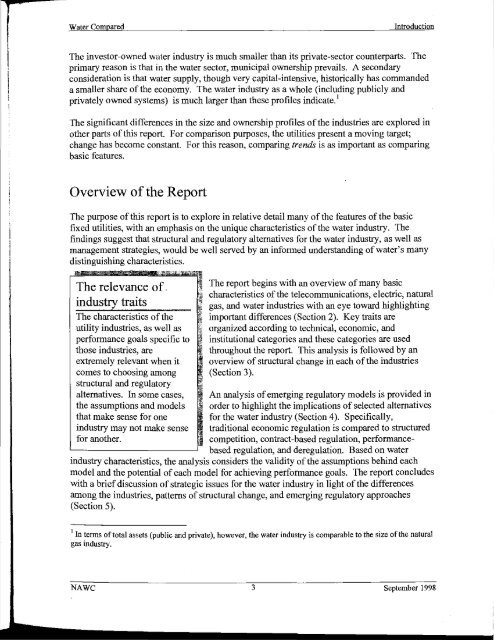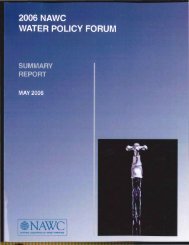BEECHER - NAWC
BEECHER - NAWC
BEECHER - NAWC
Create successful ePaper yourself
Turn your PDF publications into a flip-book with our unique Google optimized e-Paper software.
Water ComparedIntroductionThe investor-owned water industry is much smaller than its private-sector counterparts. Theprimary reason is that in the water sector, municipal ownership prevails. A secondaryconsideration is that water supply, though very capital-intensive, historically has commandeda smaller share of the economy. The water industry as a whole (including publicly andprivately owned systems) is much larger than these profiles indicate. 1The significant differences in the size and ownership profiles of the industries are explored inother parts of this report. For comparison purposes, the utilities present a moving target;change has become constant. For this reason, comparing trends is as important as comparingbasic features.Overview of the ReportThe purpose of this report is to explore in relative detail many of the features of the basicfixed utilities, with an emphasis on the unique characteristics of the water industry. Thefindings suggest that structural and regulatory alternatives for the water industry, as well asmanagement strategies, would be well served by an informed understanding of water's manydistinguishing characteristics.The relevance of. ~ The report begins with an overview of many basic~ characteristics of the telecommunications, electric, naturalindustry traits ~ gas, and water industries with an eye toward highlightingThe characteristics of the ~ important differences (Section 2). Key traits are,,"futility industries, as well as organized according to technical, economic, andperformance goals specific tothose industries, areextremely relevant when itcomes to choosing among (Section 3).~structural and regulatoryalternatives. In some cases,the assumptions and modelsthat make sense for oneindustry may not make sensefor another.institutional categories and these categories are usedthroughout the report. This analysis is followed by anoverview of structural change in each of the industries- An analysis of emerging regulatory models is provided inorder to highlight the implications of selected alternativesfor the water industry (Section 4). Specifically,traditional economic regulation is compared to structured;l!competition, contract-based regulation, performancebasedregulation, and deregulation. Based on waterindustry characteristics, the analysis considers the validity of the assumptions behind eachmodel and the potential of each model for achieving performance goals. The report concludeswith a brief discussion of strategic issues for the water industry in light of the differencesamong the industries, patterns of structural change, and emerging regulatory approaches(Section 5).1In terms of total assets (public and private), however, the water industry is comparable to the size ofthe naturalgas industry.<strong>NAWC</strong> 3 September 1998
















